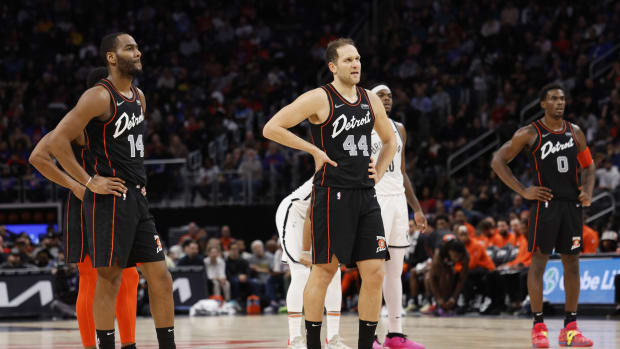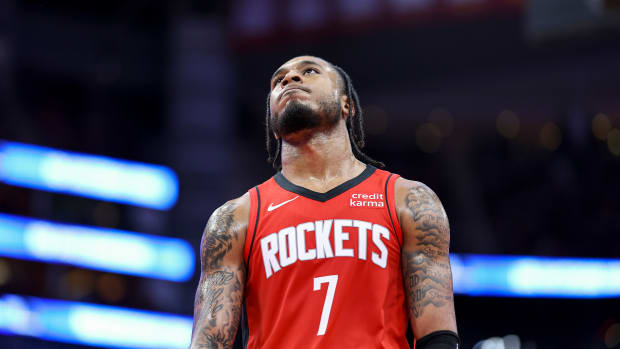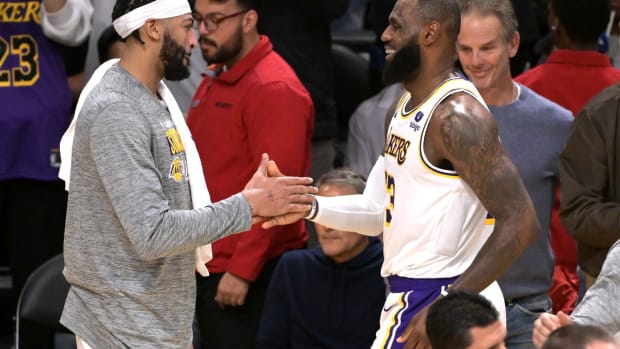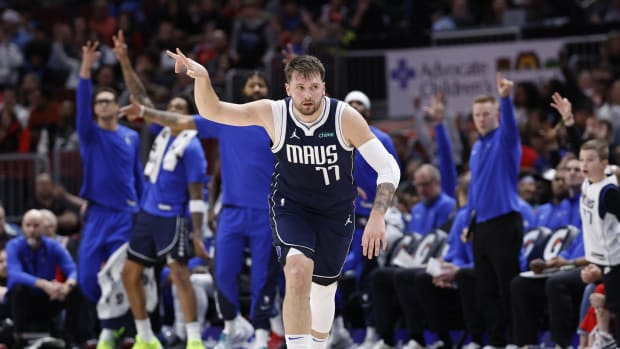What We Learned About Kentucky's Pro Prospects During Its Bahamas Trip
Basketball’s offseason is always shorter than we think, and it’s even shorter for NBA scouts. Case in point: with a host of teams represented, the Kentucky Wildcats, a pro-prospect factory in their own right, went undefeated last week over the course of a four-game exhibition series in the Bahamas. While the Crossover’s Front Office didn’t make the trip to Paradise Island (alas), we tuned in for the entire slate of games to check in with Kentucky’s new team.
The Wildcats looked well-prepared and energetic in four contests last week, facing the Bahamas national team, Argentine club San Lorenzo de Almagro, Serbian club Mega Bemax (which featured draft prospect Goga Bitadze and has produced a number of draft picks in recent years) and a team of journeymen from Toronto that included former Orlando Magic forward Andrew Nicholson. It was a relatively solid level of competition, if not a massive challenge, and a litmus test the Wildcats passed with flying colors. As is custom during John Calipari’s one-and-done heavy tenture, this is a very different Kentucky roster: only three rotation players are back, only one upperclassman is due for real minutes, Kevin Knox, Shai Gilgeous-Alexander and others are off to the NBA, and two other players transferred out.
Answering the Nine Biggest 2019 NBA Draft Questions
Rest assured that this is another athletic, talented Kentucky rotation that will be worth watching closely come fall. There are fewer surefire one-and-done guys than normal and point guard play could prove an Achilles’ heel, but this group visibly enjoys playing together already. If that level of chemistry holds up, it should be a successful season. The exhibition games provided a nice opportunity to evaluate these players. Yes, we’re seriously discussing the merits of college prospects with the season still three months away… but at least nobody can say they haven’t even played a game yet.
P.J. Washington
Position: F/C | Height: 6’8” | Weight: 235 | Year: Sophomore
Unsurprisingly, Washington’s decision to return to college for another season is a major needle-mover for Kentucky. He put together a productive week in the Bahamas, averaging 14.5 points and 7.5 rebounds, making an impact defensively and draining a few encouraging three-point attempts, as well. He’ll be a major part of his team’s success, and continues to succeed at 6’8” by leaning on a massive 7’2” wingspan. Washington weighed turning pro, but will have a better chance to be a first-round pick next spring in what’s expected to be a thinner draft in terms of depth and quality. His overall effort and consistency were positives, and he’ll be expected to take a step forward with added minutes and opportunity.
The key for Washington this season is displaying his versatility, which to some extent has stemmed more from lip service than substance to this point in his career: he wasn’t crazy efficient as a scorer in any one area as a freshman, with post-up play and offensive rebounding being his primary modes of production. While an ideal scenario would see him develop into a floor-spacing four-man, his jump shot will have to be much more consistent for that to happen. Washington has some ball skills, but probably lacks the playmaking feel and creativity to fill a perimeter role beyond setting ball screens and potentially keeping defenders honest from the corners and wings. If all that comes together, he could be a valuable two-way NBA piece with enough skill and defensive mobility to fill a role. If the secondary areas of his game don’t quite pan out, he could end up strictly a small-ball center with average rim protecting qualities.
Keldon Johnson
Position: G/F | Height: 6’6” | Weight: 210 | Year: Freshman
Johnson’s play in the Bahamas confirmed suspicions that he should be unequivocally considered Kentucky’s top pro prospect and potential leading scorer. A strong, long wing who plays both ends of the floor with relentless effort, Johnson boasts an impressively well-rounded, mature set of strengths for an 18-year-old. He shot 52.5% from the floor and averaged 13.3 points and 4.8 rebounds over the course of the Wildcats’ four wins and was a notable tone-setter for the rest of the team. He has legitimately earned his reputation as a competitor, and after seeing him up close a handful of times in different settings, it’s evident that Johnson’s approach is often contagious, and helps to keep teammates locked in.
While admittedly some of the conversations surrounding players and their intangibles can seem inherently cliché—it’s a conversation made more for television pundits than objective analysis—in Johnson’s case, NBA scouts have begun to notice those positive traits. His effort really sets him apart, and for a player who’s been relied upon to score throughout his career, his consistent effort as an on-ball defender in spite of that workload is commendable. That comes on top of his crafty slashing skills, composed mid-range package and projectable stroke. If there’s a knock on Johnson, it’s a lack of elite shiftiness off the dribble and passing skills that are somewhere around average. While Johnson is more likely to end up as a secondary scoring option long-term, he feels like a very good bet to maximize his talent and reach his ceiling. He’s a fun watch and a definite one-and-done candidate.
Tyler Herro
Position: SG | Height: 6’5” | Weight: 190 | Year: Freshman
Although he came off the bench for three of the four games, Herro was pretty consistent all week and led the Wildcats in scoring, averaging 17.3 points per game and shooting an efficient 57.5% from the field, 44.4% from three, and maintaining a perfect free throw clip on 15 attempts. It’s evident that he has the chops to pace Kentucky as a perimeter threat all season, although his numbers surely won’t be quite so gaudy over the course of 30-some games as fatigue sets in and his shot selection likely broadens. There’s definitely reason for excitement, as Herro’s pull-up game, footwork and feel for scoring are all advanced at this stage, and he’s better working off the dribble than some have given him credit for.
For NBA Insiders, the NCAA Rule Changes Arrive with Confusion and Skepticism
From a pro perspective, Herro’s case falls into more of a grey area at this stage, and it will take more time to properly assess. It’s clear that he can confidently shoot the ball at a promising level and score in different ways, but he’s a bit slow-footed defensively, has a suboptimal wingspan at 6’4", and had some trouble chasing opponents around screens in the Bahamas. He’s a player teams should be trying to exploit on that end, and that may never change. For points of comparison, Jerome Robinson, Luke Kennard and Kevin Huerter all played their way into Top 20 selections in the past two drafts as guards with high offensive potential and residual questions surrounding their defensive versatility. All three of those players possess more of an innate playmaking element to their game, something Herro doesn’t have quite as much of at this stage. The NBA still tends to prioritize offensive talent over all else, and as long as he keeps putting it in the basket, he’ll get serious looks. How much his game expands, and in what directions, will determine whether one-and-done is a viable path for Herro next spring.
Reid Travis
Position: F/C | Height: 6’8” | Weight: 240 | Year: Senior (Grad)
As an immovable bully-ball center, Travis is a bit of a throwback who should benefit from Kentucky’s platform after transferring in from Stanford for a graduate season. He will be 24 by the time the 2019 draft comes around, which will limit how high he’ll be selected, but with his impressive physical talent, elite rebounding skills and positive intangibles, it seems likely that Travis will end up squarely in the second round conversation. He only started one of Kentucky’s four games in the Bahamas, but it’s obvious he’ll play pivotal minutes and be relied upon to produce.
Travis’s NBA future, likely as a small-ball center, hinges on two things—his defensive versatility and his ability to consistently finish in the paint. Travis will have to continue to show that his lateral quickness will let him switch ball screens, and that his vertical explosiveness will compensate for a lack of height when it comes to protecting the basket. Offensively, while he hit two threes in the Bahamas and has some face-up capability, his chief value will likely come as a ball-screen option and putback specialist. Travis is thickly built and can hold position just fine, but relies more on craft than power beneath the rim and had some shooting struggles over the course of four games. He did shoot 55% from the field over four years at Stanford, which is most likely a better indicator. If it all comes together, he could find himself on the cusp of sticking in the NBA, in the mold of elite rebounders like Kenneth Faried or Alan Williams.
Nick Richards
Position: C | Height: 6’11” | Weight: 245 | Year: Sophomore
After a disappointing freshman year in which Richards frequently appeared lost on the court and played few minutes in the second half of the season, Kentucky fans and scouts alike are banking on a step forward from the toolsy big man. It’s unclear at this stage how confident anyone should be in a sophomore breakout, but Richards’s massive athletic potential was evident as he stepped into a bigger role in the Bahamas. You won’t find many young centers his size who can match his fluidity and mobility (or 7’3” wingspan), and he showed off what looked to be an improved jump hook while shooting 80% from the floor on 20 attempts. He also shot an impressive 84% from the foul line. In an era where rim-running centers can succeed in the NBA without overly complex offensive roles, Richards still certainly has a chance to make it all work in his favor.
That said, there’s still reason for concern. Richards is a sophomore, but will turn 21 in November, placing him in a bracket with juniors as far as the age curve goes. He’s a capable finisher around the basket, but is far enough behind in terms of skill level to where it’s unlikely he ever becomes a player who creates any offense for himself. He should be able to rebound competently and hold his own from a physical standpoint, but on some level, this is the player he is. Most glaringly, Richards is a rim protector who committed 5.6 fouls per-40 minutes last year. In the Bahamas, he committed nearly as many of those (17) as he grabbed rebounds (19). Richards’s next step as a prospect begins with improved discipline and floor IQ. He could play his way into good position for 2019, but it could also be a longer wait.
Ashton Hagans
Position: G | Height: 6’3” | Weight: 190 | Year: Freshman
It’s readily apparent that Hagans is Kentucky’s most talented ball-handler, and while he started just one of the four games last week, it’s possible he ends up handling a larger share of the minutes at point guard. It would appear he made a good decision to reclassify, as his contributions, good or bad, will end up pivotal to his team’s success. Hagans has a long, strong frame and was most impressive on the defensive end, offering consistent ball pressure and making life difficult for opposing guards. That part of his game seems like a great bet to translate at the college level and onward, and his consistent energy in pursuit helped set a strong tone for the rest of the team.
Offensively, Hagans was a bit of a mixed bag, with some feel for setting up teammates, but without the developed playmaking feel that Shai Gilgeous-Alexander displayed for the Wildcats last season. He’s highly unselfish, which will help his case, and should grow into that role with more time to settle in, but he’s far from mature as a passer. You’d like to see Hagans be more aggressive driving into the paint and scoring—he also attempted just two three-pointers and didn’t exude confidence in his jumper. How much Hagans can improve as a point guard over a short period of time will determine where he falls in the 2019 draft conversation, but he’s a long-term prospect worth tracking.
Immanuel Quickley
Position: G | Height: 6’3” | Weight: 185 | Year: Freshman
Quickley’s game is more workmanlike than flashy, for better or worse. He bears some similarities to Hagans in that regard, with a similarly mature body that helps him on the defensive end. Offensively, he’s a bit more polished, with repeatable shooting mechanics and a fundamentally sound game that lets him work both on and off the ball. When Calipari deployed Quickley and Hagans as a duo, the team was at its best defensively, forming an aggressive tandem you should expect to see frequently. Quickley is the more mature player and has the inside track to start games in November.
Answering the Nine Biggest 2019 NBA Draft Questions
While not a big-time scorer nor a highly creative passer, Quickley is fairly steady for his age and managed to turn the ball over just twice while totaling 18 assists in 96 minutes in the Bahamas. There were times where he forced shots, which will hopefully subside a bit as the Wildcats sort out roles more, but his lack of burst and pace off the dribble will end up limiting how much he can be leaned on for instant offense, as well as his long-term upside. Though a solid, college-ready player, Quickley doesn’t scream one-and-done. He profiles more as a game-managing guard at the next level, and he has the basic strengths to fit into that sort of role nicely at some point in time.
E.J. Montgomery
Position: F/C | Height: 6’10” | Weight: 230 | Year: Freshman
Unfortunately, Montgomery only played in the first of Kentucky’s four games due to a lower back issue. While he doesn’t seem ticketed as a starter for the Wildcats this season, the All-American big was productive in his 19 minutes of game time and showed the offensive skill and rebounding ability that have him on the NBA radar. A lefthanded jump shooter with face-up skills, Montgomery looked confident finishing with both hands and left some room for long-term optimism. As part of crowded frontcourt, it’ll be less about how much he plays and more about what he gives Kentucky during those minutes, as he can be prone to floating in and out of games. Given his tools, skill level at his size and long-term potential, Montgomery theoretically could have an opportunity to turn pro in the spring. That being said, this is a situation that could break either direction based on his performance.
Quade Green
Position: G | Height: 6’0” | Weight: 170 | Year: Sophomore
Green was more or less underwhelming as a freshman, falling in as a reserve behind Shai Gilgeous-Alexander and averaging 9.3 points on 45% shooting in 25 minutes per game. He was highly touted coming out of high school in Philadelphia and will have the requisite role to restore his reputation a bit this season. As the elder statesman in the backcourt, Kentucky will lean on Green for stability, even in what appears to be a more off-ball focused role. He shot the ball well in the Bahamas, but still has bouts of poor decision-making and streaky shooting and runs into trouble finishing around the basket. That coupled with a lack of great size and athleticism makes him a difficult sell from an NBA perspective. Regardless, Green will need to take a step forward for the Wildcats to maximize their success.





































